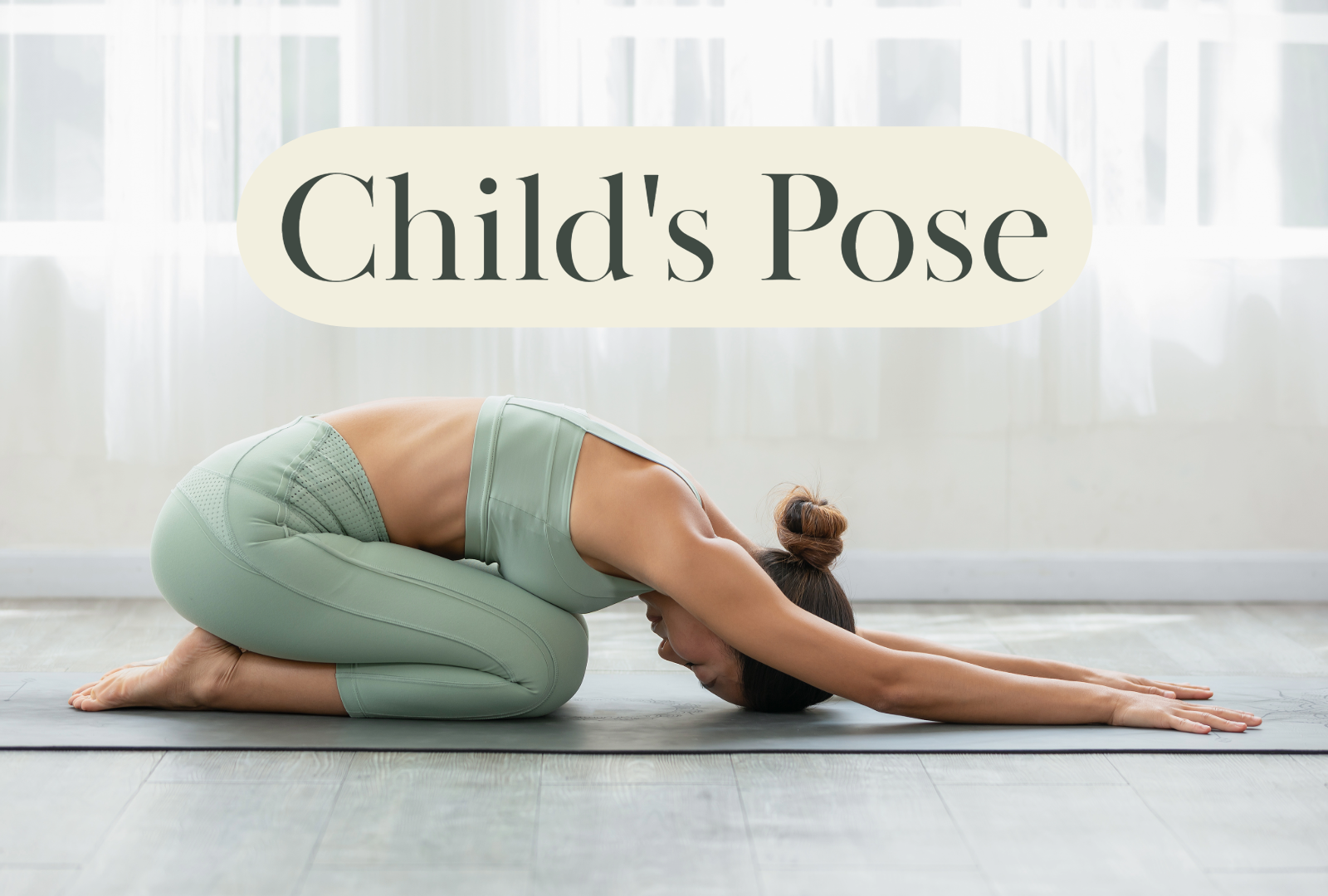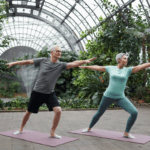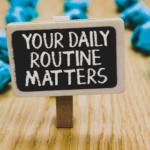Coming Soon: E-book about Kundalini Yoga - Sign up here to be among the first to get it!
Sanskrit: Balasana
Type: Prone Pose, Kneeling Pose, Hand to Feet
Chakra Involved: Crown Chakra (Sahasrara Chakra), Third Eye Chakra (Ajna Chakra), Solar Plexus (Manipura Chakra), Sacral Chakra (Swadisthana Chakra), Root Chakra (Muladhara Chakra)

Child’s Pose (Balasana)
Child’s Pose, or Balasana, is a restorative, calming yoga posture that symbolizes surrender and relaxation. It gently stretches the lower back, hips, thighs, knees, and ankles, while reducing stress and fatigue. Balasana is often used as a resting position between more challenging poses and is beneficial for digestion and calming the mind.
Starting Position
Begin on your hands and knees in a tabletop position. Ensure your knees are set directly below your hips, and your hands are slightly forward of your shoulders.
Step-by-step Instruction
- Spread Your Knees: Widen your knees to the edges of your mat while keeping your big toes touching. Sink your hips back towards your heels. If your buttocks don’t reach your heels, place a folded blanket or pillow between your thighs and calves for support.
- Extend Forward: Exhale as you lay your torso down between your thighs. Place your arms alongside your body, palms up, for a more relaxed shoulder stretch.
- Relax Your Forehead: Gently rest your forehead on the mat. If your forehead doesn’t comfortably reach the mat, use a block or folded blanket for support.
- Deepen the Pose: To deepen the stretch in your hips and back, gently press your chest down towards the mat. Breathe deeply, allowing your body to relax further into the pose with each exhale.
- Hold the Pose: Stay in this position for 30 seconds to a few minutes, depending on your comfort level. Focus on deep, steady breaths to enhance relaxation and stress relief.
To Release the Pose
- Use Your Hands: Gently use your hands to press yourself back up to a sitting position on your heels. Move slowly to allow your body to adjust.
- Return to Tabletop: If preferred, you can transition back into a tabletop position to continue your practice or move into another pose.
Teacher’s Tip
- Breathing: Encourage students to focus on their breath, using deep inhales and exhales to sink deeper into relaxation. The breath should be slow, deep, and deliberate.
- Modifications: For students with knee discomfort, placing a folded blanket under the knees can provide additional cushioning. For those who find it hard to sit back on their heels, a bolster or pillow between the thighs and calves can offer support.
- Focus on Relaxation: Remind students that Child’s Pose is a restorative and calming posture. They should aim for relaxation and comfort, adjusting their position as needed to find a gentle stretch without strain.
- Integration: Suggest using Child’s Pose as a transition between more intense poses to center the breath and calm the mind, making it an integral part of their practice for both physical and mental rest.
Child’s Pose serves as a gentle reminder to turn inward, offering a moment of peaceful reflection and relaxation in a yoga practice.
Variations of Child’s Pose (Balasana)
Child’s Pose is a foundational yoga posture with several variations to accommodate different levels of flexibility, comfort, and individual needs. Here are some common variations along with instructions for each:
1. Extended Child’s Pose
- Instructions: From the classic Child’s Pose, extend your arms forward as much as possible, spreading your fingers wide. This increases the stretch in the shoulders and lengthens the spine further.

2. Wide-Knee Child’s Pose
- Instructions: Widen your knees as far apart as comfortable while keeping your big toes touching. Sink your hips back towards your heels and stretch your arms forward. This variation provides a deeper hip opener.
3. Child’s Pose with a Twist
- Instructions: From Child’s Pose, thread your right arm underneath your left with your palm facing up, and lay your right cheek on the mat. Hold for several breaths, then switch sides. This adds a gentle twist to the spine and stretches the shoulders.
4. Child’s Pose with a Bolster
- Instructions: Place a bolster or a thick blanket lengthwise between your thighs. Lower your torso onto the bolster and turn your head to one side. This is a more restorative variation, offering support and allowing for deeper relaxation.
5. Child’s Pose with Block under Forehead
- Instructions: If your forehead doesn’t comfortably reach the mat, place a yoga block or folded blanket under your forehead for support. This ensures neck comfort and relaxation.
6. Child’s Pose with Arms Alongside the Body
- Instructions: Instead of extending your arms forward, bring your arms alongside your body with your hands resting near your feet, palms up. This variation reduces the stretch in the shoulders, offering a more restful posture.
7. Child’s Pose with Ankle Stretch
- Instructions: From the standard Child’s Pose, lift your buttocks slightly and tuck your toes, stretching the soles of your feet and your ankles. Hold this position before settling your hips back down onto your heels.
Implementation Tips
- Use Props: Encourage the use of props like bolsters, blocks, and blankets to make the pose more comfortable, especially for beginners or those with tight hips or shoulders.
- Focus on Breath: Remind students to maintain deep, steady breathing throughout the pose to enhance relaxation and the stretching effect.
- Adjustments: Encourage students to make any necessary adjustments to find a comfortable position, emphasizing that Child’s Pose should feel restful and nurturing.
- Listen to the Body: Advise students to listen to their bodies and choose the variation that best suits their needs on any given day, avoiding any strain or discomfort.
Exploring these variations can help students find the version of Child’s Pose that best suits their body and needs, making it a truly personalized and comforting experience.
FAQs About Child’s Pose
Child’s Pose (Balasana) is a restorative, calming pose with several benefits:
- Relieves Tension: It helps release tension in the back, shoulders, and chest.
- Promotes Relaxation: Encourages a state of relaxation and can help reduce stress and anxiety.
- Stretches the Hips, Thighs, and Ankles: Offers a gentle stretch to the hips, thighs, and ankles.
- Aids Digestion: The forward fold can massage internal organs, aiding digestion.
- Encourages a Restorative Pause: Serves as a moment of rest in your practice, allowing you to reconnect with your breath.
- Flexibility: Increases spine flexibility and can relieve neck and lower back pain when the head is supported.
While Child’s Pose is gentle and accessible to many, certain individuals should avoid it or modify it:
- Knee Problems: Those with severe knee injuries or discomfort may find it painful to compress the knees in this position.
- Pregnant Women: Later in pregnancy, the traditional version of Child’s Pose can be uncomfortable due to the pressure on the abdomen. A wide-legged version can be a safer alternative.
- High Blood Pressure: Those with high blood pressure should approach this pose with caution, especially without head support.
Child’s Pose can be held anywhere from 30 seconds to a few minutes, depending on your comfort level and the intention behind your practice. It can be used as a brief resting pose between more challenging poses or as a longer, more meditative posture to deeply relax and unwind.
Yes, Child’s Pose can be beneficial for alleviating lower back pain:
- Stretches and Relaxes the Spine: By gently stretching the spine, it can relieve tension and pain in the lower back.
- Supports Natural Curvature: It allows the spine to rest in its natural curvature, which can help soothe back discomfort.
- Modifications for Comfort: For those with significant lower back pain, placing a cushion or folded blanket under the thighs or between the calves and thighs can provide additional support and reduce strain on the lower back.
Child’s Pose is often recommended as part of a gentle yoga practice for those recovering from back injuries or experiencing chronic back pain, but it’s important to listen to your body and adjust the pose as needed for your comfort.




